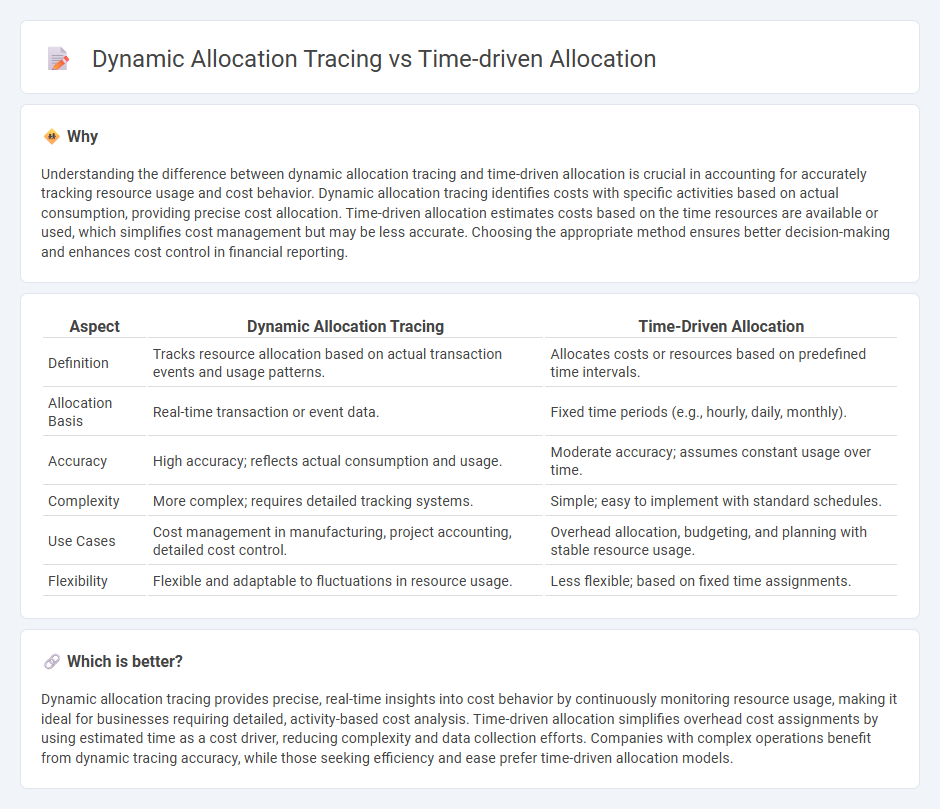
Dynamic allocation tracing tracks real-time resource usage by monitoring transactions and activities continuously, offering precise cost distribution based on actual consumption patterns. Time-driven allocation estimates costs by assigning resource expenses according to the time each activity consumes, simplifying the allocation process with predefined time metrics. Explore these methods further to determine which approach best enhances your accounting accuracy and efficiency.
Why it is important
Understanding the difference between dynamic allocation tracing and time-driven allocation is crucial in accounting for accurately tracking resource usage and cost behavior. Dynamic allocation tracing identifies costs with specific activities based on actual consumption, providing precise cost allocation. Time-driven allocation estimates costs based on the time resources are available or used, which simplifies cost management but may be less accurate. Choosing the appropriate method ensures better decision-making and enhances cost control in financial reporting.
Comparison Table
| Aspect | Dynamic Allocation Tracing | Time-Driven Allocation |
|---|---|---|
| Definition | Tracks resource allocation based on actual transaction events and usage patterns. | Allocates costs or resources based on predefined time intervals. |
| Allocation Basis | Real-time transaction or event data. | Fixed time periods (e.g., hourly, daily, monthly). |
| Accuracy | High accuracy; reflects actual consumption and usage. | Moderate accuracy; assumes constant usage over time. |
| Complexity | More complex; requires detailed tracking systems. | Simple; easy to implement with standard schedules. |
| Use Cases | Cost management in manufacturing, project accounting, detailed cost control. | Overhead allocation, budgeting, and planning with stable resource usage. |
| Flexibility | Flexible and adaptable to fluctuations in resource usage. | Less flexible; based on fixed time assignments. |
Which is better?
Dynamic allocation tracing provides precise, real-time insights into cost behavior by continuously monitoring resource usage, making it ideal for businesses requiring detailed, activity-based cost analysis. Time-driven allocation simplifies overhead cost assignments by using estimated time as a cost driver, reducing complexity and data collection efforts. Companies with complex operations benefit from dynamic tracing accuracy, while those seeking efficiency and ease prefer time-driven allocation models.
Connection
Dynamic allocation tracing and time-driven allocation are connected through their mutual focus on accurately tracking resource usage over specific periods. Dynamic allocation tracing monitors memory allocation in real-time, providing granular insights into how resources are distributed during execution. Time-driven allocation leverages this data to optimize resource planning and cost management in accounting systems by aligning expenses with actual usage intervals.
Key Terms
Cost Driver Rates
Time-driven allocation employs predefined cost driver rates based on standard time metrics, providing consistent and straightforward cost assignment. Dynamic allocation tracing adjusts cost driver rates in real-time according to actual resource consumption, enhancing accuracy in cost distribution. Explore the nuances and benefits of each approach to optimize your cost management strategies effectively.
Resource Capacity
Time-driven allocation tracing monitors resource capacity by examining predefined intervals to identify utilization patterns, ensuring efficient workload distribution. Dynamic allocation tracing adapts in real time, capturing fluctuating resource demands and enabling precise capacity management under variable conditions. Explore more about optimizing resource capacity with advanced allocation tracing methodologies.
Real-time Data
Time-driven allocation tracing captures memory usage at fixed intervals, providing consistent snapshots of real-time data allocation trends in applications. Dynamic allocation tracing records memory events as they occur, offering granular insights into real-time allocation behavior and helping identify performance bottlenecks. Explore these methods further to optimize real-time data handling and enhance system responsiveness.
Source and External Links
Time Driven Activity Based Costing (TDABC): A Complete Guide - TDABC allocates costs based on the actual time required for each activity, using two key parameters: the unit cost of supplying capacity and the estimated time per activity, which simplifies implementation and improves cost accuracy.
TIME-DRIVEN OR DRIVER RATE-BASED ABC? - Time-driven allocation uses time equations to assign costs at a granular level (e.g., per invoice), ensuring expenses are charged based on the precise time taken for each transaction rather than aggregated averages.
Time-Driven ABC | Strategic Cost Management Class Notes - Time-driven ABC simplifies cost allocation by focusing on time as the primary cost driver, enabling easier updates, granular insight into inefficiencies, and better decision-making through capacity utilization measures.
 dowidth.com
dowidth.com